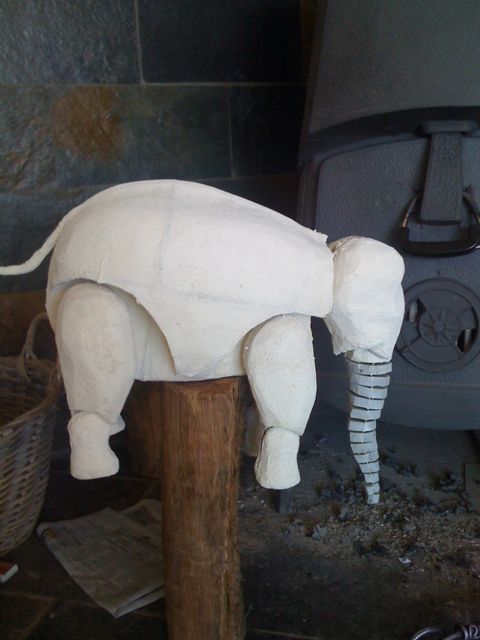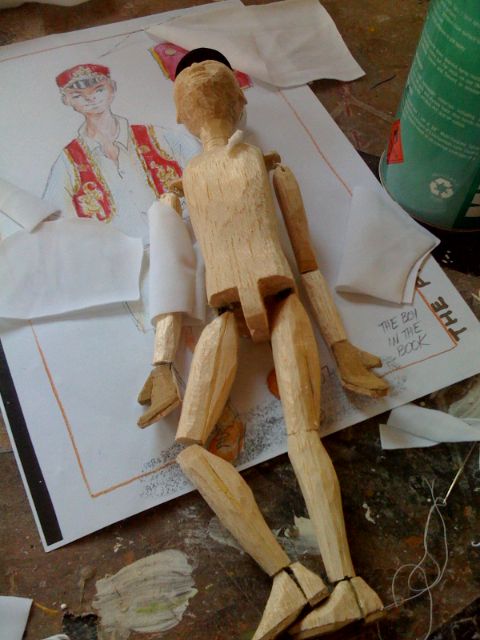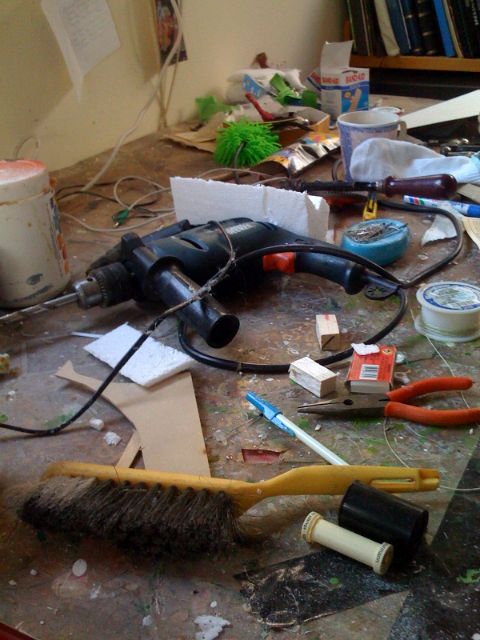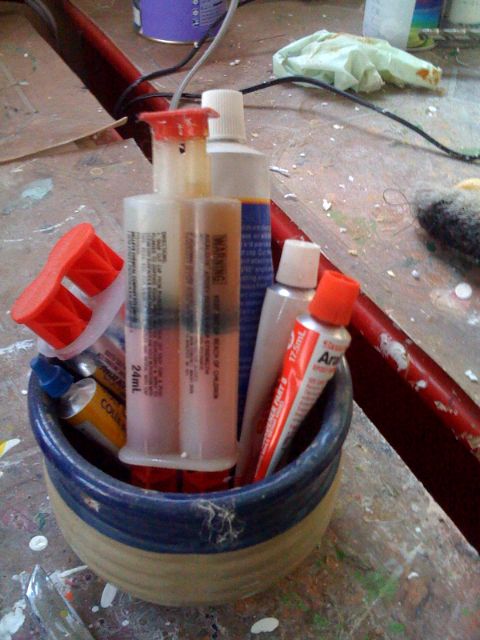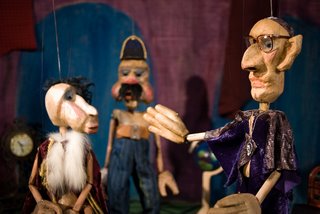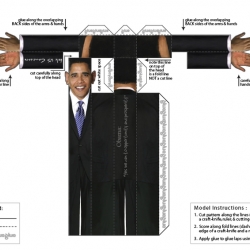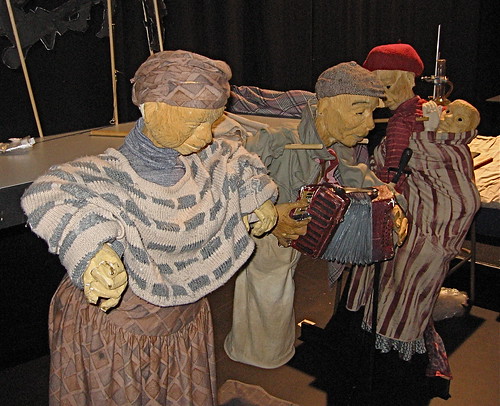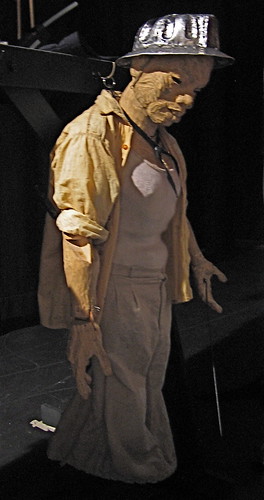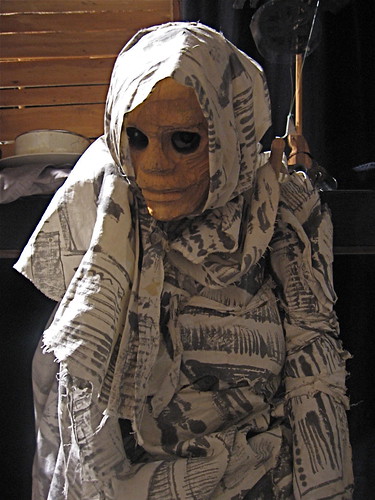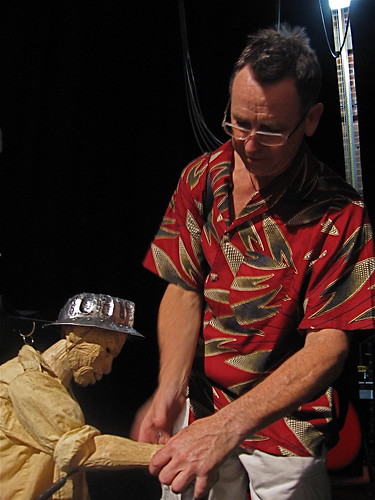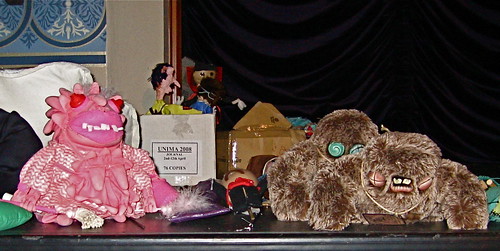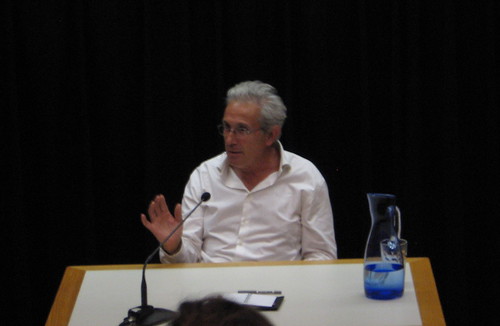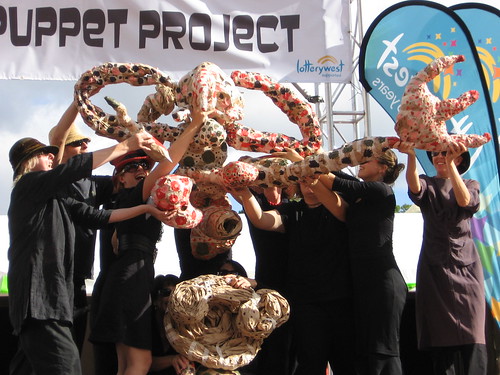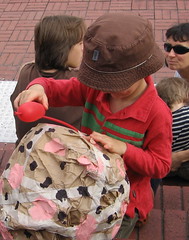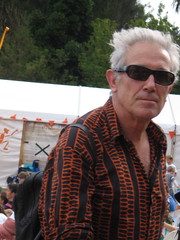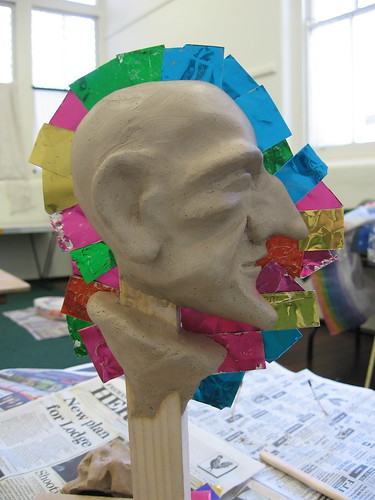Photos from my studio yesterday, and the elephant drying by the fire overnight.
puppets
Looking for a monster
(photo: Sidat de Silva)
Looking for a Monster is based on an original puppet play written by a thirteen year old boy, Hanus Hachenburg in the Terezin concentration camp in 1943, shortly before his transportation to the Auschwitz Death Camp. In 1999, puppeteer Gary Friedman discovered the play in a Jerusalem archive. It was performed for the first time in 2001 and has just been filmed in Sydney for inclusion in Gary’s documentary film about the life of Hanus Hachenburg. Gary has a slideshow of photos taken at the shoot in the sidebar of his blog, Puppetry News, and you can also see individual photos in this gallery.
Incidentally, Gary is running another Puppetry for TV course starting in June.
Felt Obama finger puppet
Following on from yesterday’s post about candidate finger puppets made from card, Abbey Hambright has felt finger puppets of Obama for sale.
Fold US candidates
FoldUScandidate has patterns for card finger puppets of the three US candidates. You print from a pdf and the assemble as shown. Check out the videos and photos that some people have submitted of their puppets.
Handspring’s Woyzeck on the Highveld
On the last day of Unima 2008 Gary introduced me to his friends Adrian Kohler and Basil Jones, who co-founded and continue to run Handspring Puppet Company, and I was lucky enough to go backstage to see the puppets from Woyzeck on the Highveld. Thank you all!
The play itself had been a festival highlight for me. First staged 16 years ago, it tells the story of Woyzeck, a man of sensibility and principle, who is brought down by jealousy; but his struggle is informed in every way by the hardships of the migrant labour system under apartheid in the South Africa of the 1950’s.
Two aspects of the show intrigued me in particular.
One was the power of director William Kentridge’s back-projected animations which formed part of the backdrop to the set. They provided not only physical settings to the action and shadow puppets, but at times gave excruciating visual metaphors for what characters were thinking and feeling. For instance, in one scene, Woyzeck is worrying about setting his master’s table. He is doing fine in reality, but in contrast, as he gets increasingly anxious about doing it perfectly, the animation shows great smudges and spills amassing into a chaos that ends in, among other things, a plane crashing and burning.
The other was, of course, the puppets. They are bunraku-style puppets, with beautifully expressive carved (and hollowed out) wooden heads and hands. Adrian is the master puppet maker and designer. He explained how after touring Woyzeck extensively for some years, the company saw selling the puppets as the only way to move on to doing new work. Their latest production, Warhorse, would have been too big to tour, and fortunately, to their surprise, the Munich City Museum was happy to lend the puppets back for the gig at Unima 2008.
Margaret (?), Andries, with the accordion, and Maria with her baby:
The Miner:
The mysterious newspaper death-like character:
Adrian Kohler with the Miner, explaining how the implements in his hand can be changed:
The rhino, showing the rods and mechs on the operator’s side. There is a universal joint in it’s sternum. The red bulb is it’s bladder! (not to be confused with the 2 red chairs in the background).
Here is a video of the rhino in action. You can hear Gary and Adrian chatting.
I loved the rhino most, because it has so much character, and moves in such a life-like way, while being impressionistic in style. I’m very interested in this. Kohler has developed the style much further, too, since building the rhino, as you can see if you look at the horses in Warhorse. Warhorse is the first production where Handspring has moved away from performing their own work, and Adrian commented there were advantages in being solely a maker at times, rather than being a maker/puppeteer.
Incidentally, Handspring is hoping to bring out a DVD of Woyzeck, including the animations, and there is to be a new season of Warhorse in London later in 2008. There’s just a chance I might around to catch it!
Articles I enjoyed reading about Handspring:
Paul Vincett: Monster Workshop puppets
I was very taken with the cool Monster Workshop puppets, particularly the leathery demon puppets (above and below right), that were sent in to the Million Puppet Project at Unima 2008. They were made by Paul Vincett, a 3D illustrator and puppet maker. They were behind glass, so difficult to photograph well, but you can find great pictures on his website, for example here or here.
About 40 of the puppets that were sent in to the Million Puppets Project were auctioned at the end of the festival, and I think the one above right brought in the highest bid of the night. Below you can see two of the furry monsters who had just been adopted on auction night, and the very pink Loverly Gloverly who also went for a top price.
There are two videos of the demon puppets online (I love the way one of them shakes its ears in such an animal kind of way):
Buried and forgotten and this one:
A tiger by the tail?
(My favourite so far: Steve Gillmor)
Despite my own mixed feelings, I’m expecting Loren Feldman’s Shel Israel parody to become the hottest puppet video show around while it lasts. Feldman has caused mischief and grief by taking the piss, and nicking the real Shel’s domain. You can read about it at Techcrunch or Karoli’s Bang the Drum, and here Feldman explains his initial impetus.
But it’s funny. As Steve Gillmor says in NewsGang Live (04.02.08, about the 45 -55 min mark), it’s the kind of thing you feel guilty about laughing at, but you can’t stop yourself. At first I was nitpicking the lip syncing, but Feldman is a quick study, and seems a natural for what works dramatically. (Update May 09 : not quick enough – he still can’t lip sync.)
I’m not sure if it’s so funny if you don’t follow the tech scene, but it’s interesting to see such a connection drawn between the tech world and the online puppetry world. There are precious few of us that follow both. I am intrigued to see who is willing to be interviewed, their differing comfort levels, and of course the power that resides in the way a puppet can ask questions and go places that a real interviewer can’t. The tech world seems to take itself fairly seriously much of the time, and I think Feldman may have a tiger by the tail with his entertaining and cutting take (though I’m sure it’s also going to be unkind and is already feeding into personality feuds). No wonder he is buying more puppets today.
Joan Baixas’ Terra Prenyada at Unima 2008
(Joan Baixas’ keynote at Unima 2008)
Gary Friedman has a small clip and description of a secret performance of Terra Prenyada (The Pregnant Earth) by the master puppeteer and Spanish artist, Joan Baixas, at Unima 2008. You can see it full screen if you watch it at YouTube. I wish I had seen the show; it looks wonderful, a fusion of painting and theatre, done on a big sheet of back-lit plastic. I gathered from Baixas’ keynote talk that he often uses ochres that he finds locally for this, and that he began doing so when he spent time in the Australian desert, collaborating with the Arabanna community in the outback of South Australia to design and make masks for the Naidoc Festival in Maree. He also mentioned that he has a new show called Toast to Zoe, improvisations of painting and piano, with jazz pianist Agustí Fernandez.
The painting reminds me of how kids sometimes tell the story as they are drawing or painting, so that it almost becomes a live animation. For example boys of about 8 or 10 draw action scenes of battles and talk through the action: one plane turns into a flight of planes, they will be given guns, which then burst into fire as marks raining down to earth, and then a plane might crash and burn; the whole narrative on one page. It also reminds me of the kind of print where you ink up the plate and make marks on it for a one-off print.
Baixas ran a masterclass at Unima 2008, too, the Great Laughing Mutant Project. The participants presented a performance on Carnival Day, using these lovely minimalist shapes in lots of different ways:
Afterwards they gave them to kids in the crowd, and the little boy in front of me was having fun with his:
My attendence at Unima 2008 is supported by the ACT Government.
Nori Sawa’s masterclass
I’ve made a set of photos and notes that I took during Nori Sawa’s masterclass that I did at Unima 2008. Nori Sawa is a Japanese puppeteer, designer and maker who now works and teaches at the Academy of Performing Arts in Prague, and he taught us how to make a Ningyo-Joruri head. This is much the same as a traditional bunraku puppet head, having a neat neck mechanism and trigger in the handle so that the head has a smooth up-and-down action, which together with a shoulder plate that sits loosely locked around the neck (we didn’t have time to make this), gives the character a very flexible head and neck movement.
There were six of us doing the class (from Canberra, Melbourne, Hobart, Adelaide, Sydney and Alice Springs – how’s that for a good national spread?) and it went over the first 3 1/2 days of the festival. For me it proved a good way of learning some new skills and settling into the festival and getting to make some new friends, including Naomi Guss, whose blog I have been reading for some time now. It was good to finally meet her in person, and spend some time with her.
(Naomi and Nori, Kristen, Jill, Kathy, Frances and Vanessa (one of the organisers) – click to enlarge)
The making process involved sculpting a clay head; making a plaster mold; creating a hollow paper mache head by paper mache-ing inside the two halves of the mold and joining the resulting paper shells; shaping and joining the wood to make a handle, trigger and neck; stringing the trigger mechanism; and finally situating and attaching the neck into the head with an axle and elastic for return on the trigger. A lot to achieve in the time – we had a battle to get each stage dry and used hairdryers borrowed from our hotels, a microwave, the sun, and eventually a pie warmer to get there! I loved the moment when we sealed the two halves of the head together with white glue and a small red hot iron – it still seems magical to me that that works so well!
This is my puppet head in action. The clip is a little clumsy, since I was filming and operating, but it gives the idea. I haven’t decided what kind of finish to give it yet. I will at least paint the eyes.
Some aspects I don’t want to forget: The tradition in these puppets is for the chin to be prominent, and the focus of the puppeteer is on the chin, it leads the action. The eyes have a flat surface that is angled down; when the face lifts up you see the whole eye this way, and it lightens the whole character and mood. The action of the puppet and each movement it makes is that of a circle or infinity; this kind of choreography gives grace and life.
Sadly we didn’t get to see Nori perform because on the way to Australia his bag of puppets became one of the 16,ooo items lost at the choas of the shambles that is the new Heathrow Terminal 5. I’d love one day to see some of his contemporary puppets and shows that fuse Japanese and Czech design.
My attendence at Unima 2008 is supported by the ACT Government
